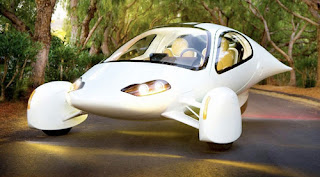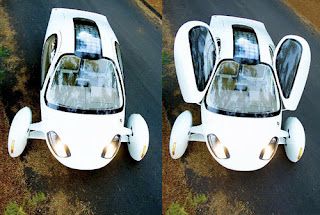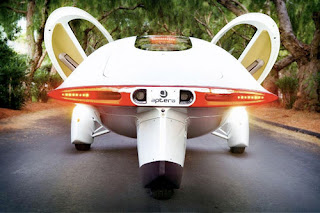
A company called XP Vehicles is developing a new kind of car... A car that if you were to drive off a cliff and flip around a couple times you would still be okay... A car that if you were to get hit by another car you would simple bounce away like a bumper car... It might be one of the future's most innovative creations - An inflatable car!
The XP Vehicles' Whisper model is an electric car built out of inflated air bags. The company claims that Whisper may be the safest car out there. It even offers to put $50,000 in an escrow account and if any of their claims are wrong then that money is yours to keep. Of course, if you drive off a cliff and don't survive then it will be difficult for you to claim that money. But it is nice to know that that money is out there.
The car has a flotation device in case of emergencies and it uses battery pack technology.
The company claims that you can get up to a 300 mile range with the Whisper. They offer a Whisper, a Whisper Sport Coupe, and a nikO SUV+. The cars should be available to the public within the next 2 to 3 months. However, it will take up to 7 months after the company closes their funding round to get the cars out on the streets.
In a few months, the company's website will allow you to build your own car online. You can decide if you would like to assemble your car on your own or have the dealer assemble it. The car takes approximately two hours two assemble with two people assembling at the same time.
The company claims that research has shown that metal in a car "is the largest cause of death and injury," according to their website. Thus, they believe that reducing metal in a car and creating an inflatable car is a lot safer.
The cars are not entirely inflatable. Their are certain aspects of the car, which require different material, such as the steering wheel.
The car will cost approximately $10,000, according to a questionnaire on the website. And it is unknown whether these cars can be certified in every city. The company says that it will be the buyer's duty to obtain certification from their city in order to drive the car.
The inflatable car also provides "ipod mounts & connects, 20 colors, trim, decals, roof, no roof, car covers, solar mounts, stereos, integrated pumps, home connections, GPS, battery clubs, alarms," according to the company's website.
Also, if there are concerns about the car blowing away, the company claims not to worry because the car has a special aerodynamic system which is supposed to keep the car pretty stable...
Overall, I think the whole idea is very cool. I think it would be wierd to have only one inflatable car on the street, but it would be cool if everyone had one.
Think about it, if you were ever to get into an accident with another inflatable car then both of you would just bounce off eachother like bumper cars. It might actually be kind of fun! The idea in general is very creative and I would love to see these cars come into town!
 Photo courtesy of flickr.com member
Photo courtesy of flickr.com member





